A Comparative Study of Spatial and Temporal Preferences for Waterfronts in Wuhan based on Gender Differences in Check-In Behavior
Abstract
:1. Introduction
2. Materials
2.1. Study Area
2.2. Data Sources and Preprocessing
3. Methods
3.1. Calculation of Relative Difference
3.2. Data Standardization by Ratio Scale
3.3. Cluster Analysis
3.4. Kernel Density Estimation
4. Results
4.1. Spatial and Temporal Changes in the Check-in Quantity of Different Genders within the Waterfront
4.2. Each Lake Buffer Zone Has Different Gender Sign-in Point Densities
4.3. Temporal and Spatial Distribution of Different Genders’ Check-In Points in Each Lake Buffer Zone
4.4. Distribution Characteristics of POI around Lakes with Gender Difference
4.4.1. Nuclear Density and Cluster Thermodynamic Analysis
4.4.2. Characteristics of Waterfront Preference and Willingness Based on Gender Difference
5. Discussion
6. Conclusions
Author Contributions
Funding
Conflicts of Interest
References
- Wu, J.; Li, J.; Ma, Y. Exploring the Relationship between Potential and Actual of Urban Waterfront Spaces in Wuhan Based on Social Networks. Sustainability 2019, 11, 3298. [Google Scholar] [CrossRef]
- Breen, A.; Rigby, D. The New Waterfront: A Worldwide Urban Success Story; Thames and Hudson: London, UK, 1996. [Google Scholar]
- Breen, A.; Rigby, D. Waterfronts: Cities Reclaim Their Edge; McGraw-Hill Companies: New York, NY, USA, 1994. [Google Scholar]
- Chen, Q.; Ye, Y.B.; Ma, L.J. Excavation and Shaping of Distinctive Elements in Landscape Planning of Modern Urban Waterfront. In Applied Mechanics and Materials; Trans Tech Publications: Stafa-Zurich, Switzerland, 2011; Volume 71, pp. 12–17. [Google Scholar]
- Boland, P.; Bronte, J.; Muir, J. On the waterfront: Neoliberal urbanism and the politics of public benefit. Cities 2017, 61, 117–127. [Google Scholar] [CrossRef] [Green Version]
- Sairinen, R.; Kumpulainen, S. Assessing social impacts in urban waterfront regeneration. Environ. Impact Assess. Rev. 2006, 26, 120–135. [Google Scholar] [CrossRef]
- Da, T.; Xu, Y. Evaluation on connectivity of urban waterfront redevelopment under hesitant fuzzy linguistic environment. Ocean Coast. Manag. 2016, 132, 101–110. [Google Scholar] [CrossRef]
- Wong, T.C. Revitalising Singapore’s central city through gentrification: The role of waterfront housing. Urban Policy Res. 2006, 24, 181–199. [Google Scholar] [CrossRef]
- Ali, S.M.; Nawawi, A.H. The Social Impact of Urban Waterfront Landscapes: Malaysian Perspectives. In Proceedings of the REAL CORP 2009, Sitges, Spain, 22–25 April 2009. [Google Scholar]
- Romero, V.P.; Maffei, L.; Brambilla, G.; Ciaburro, G. Modelling the soundscape quality of urban waterfronts by artificial neural networks. Appl. Acoust. 2016, 111, 121–128. [Google Scholar] [CrossRef]
- Shafaghat, A.; Manteghi, G.; Keyvanfar, A.; Lamit, H.B.; Saito, K.; Ossen, D.R. Street geometry factors influence urban microclimate in tropical coastal cities: A review. Environ. Clim. Technol. 2016, 17, 61–75. [Google Scholar] [CrossRef]
- Shafaghat, A.; Keyvanfar, A.; Manteghi, G.; Lamit, H.B. Environmental-conscious factors affecting street microclimate and individuals’ respiratory health in tropical coastal cities. Sustain. Cities Soc. 2016, 21, 35–50. [Google Scholar] [CrossRef]
- Wang, Y.; Wang, G. The Researches on Sustainable Development of Urban Waterfront. In Proceedings of the 2008 International Conference on Management Science and Engineering, Long Beach, CA, USA, 10–12 September 2008. [Google Scholar]
- Hoyle, B. Urban waterfront revitalization in developing countries: The example of Zanzibar’s Stone Town. Geogr. J. 2002, 168, 141–162. [Google Scholar] [CrossRef]
- Thorning, D.; Christopher, B.; Stephen, E. The delivery of mixed communities in the regeneration of urban waterfronts: An investigation of the comparative experience of Plymouth and Bristol. Land Use Policy 2019, 84, 238–251. [Google Scholar] [CrossRef]
- Gravagnuolo, A.; Mariarosaria, A. Assessment of urban attractiveness of port cities in southern Italy—A case study of Torre Annunziata. Sustainability 2013, 5, 3906–3925. [Google Scholar] [CrossRef]
- Yocom, K.P.; Andrews, L.; Faghin, N.; Dyson, K.; Leschine, T.; Nam, J. Revitalizing urban waterfronts: Identifying indicators for human well-being. Aims Environ. Sci. 2016, 3, 456–473. [Google Scholar] [CrossRef]
- Hao, X.; Wu, W. The Application of GIS to Study Urban Waterfront District Planning—A Case Study of Landscape Planning in Guyang Lake. In Proceedings of the 2013 Fifth International Conference on Measuring Technology and Mechatronics Automation, Hong Kong, China, 16–17 January 2013. [Google Scholar]
- Vollmer, D. Urban waterfront rehabilitation: Can it contribute to environmental improvements in the developing world? Environ. Res. Lett. 2009, 4, 024003. [Google Scholar] [CrossRef]
- Mostafa, L.A. Urban and social impacts of Waterfronts Development, case study: Jeddah Corniche. Procedia Environ. Sci. 2017, 37, 205–221. [Google Scholar] [CrossRef]
- Yang, C.X. The Integrative Organization among Urban Waterfront Elements. Advanced Materials Research; Trans Tech Publications: Stafa-Zurich, Switzerland, 2014; Volume 869. [Google Scholar]
- Bunce, S.; Gene, D. Introduction to Political ecologies of urban waterfront transformations. Cities 2007, 24, 251–258. [Google Scholar] [CrossRef]
- Cai, L.; Jiang, F.; Zhou, W.; Li, K. Design and Application of an Attractiveness Index for Urban Hotspots Based on GPS Trajectory Data. IEEE Access 2018, 6, 55976–55985. [Google Scholar] [CrossRef]
- Light, J.S. From Warfare to Welfare: Defense Intellectuals and Urban Problems in Cold War America; JHU Press: Baltimore, MD, USA, 2003. [Google Scholar]
- LeGates, R.; Tate, N.J.; Kingston, R. Spatial thinking and scientific urban planning. Environ. Plan. B Plan. Des. 2009, 36, 763–768. [Google Scholar] [CrossRef]
- Ford, G.B. The city scientific. Eng. Rec. 1913, 67, 551–552. [Google Scholar]
- Fairfield, J.D. The scientific management of urban space: Professional city planning and the legacy of progressive reform. J. Urban Hist. 1994, 20, 179–204. [Google Scholar] [CrossRef]
- Humphreys, L.; Tony, L. Mobile geotagging: Reexamining our interactions with urban space. J. Comput.-Mediat. Commun. 2011, 16, 407–423. [Google Scholar] [CrossRef]
- Gentes, A.; Guyot-Mbodji, A.; Demeure, I. Gaming on the move: Urban experience as a new paradigm for mobile pervasive game design. Multimed. Syst. 2010, 16, 43–55. [Google Scholar] [CrossRef]
- Paulos, E.; Goodman, E. The familiar stranger: Anxiety, comfort, and play in public places. In Proceedings of the SIGCHI Conference on Human Factors in Computing Systems, Vienna, Austria, 24–29 April 2004; pp. 223–230. [Google Scholar]
- Wang, J.; Canny, J. End-user place annotation on mobile devices: A comparative study. In Proceedings of the CHI’06 Extended Abstracts on Human Factors in Computing Systems, Montréal, QC, Canada, 22–27 April 2006; pp. 1493–1498. [Google Scholar]
- Watkins, D. Digital Facets of Place: Flickr’s Mappings of the US-Mexico Borderlands. 2012. Available online: https://0-search-proquest-com.brum.beds.ac.uk/docview/1038364267 (accessed on 13 September 2019).
- Wall, M.; Kirdnark, T. Online maps and minorities: Geotagging Thailand’s Muslims. New Media Soc. 2012, 14, 701–716. [Google Scholar] [CrossRef]
- Shelton, T.; Zook, M.; Graham, M. The technology of religion: Mapping religious cyberscapes. Prof. Geogr. 2012, 64, 602–617. [Google Scholar] [CrossRef]
- Graham, M.; Zook, M. Augmented realities and uneven geographies: Exploring the geolinguistic contours of the web. Environ. Plan. A 2013, 45, 77–99. [Google Scholar] [CrossRef]
- Pechlaner, H.; Raich, F.; Fischer, E. The role of tourism organizations in location management: the case of beer tourism in Bavaria. Tour. Rev. 2009, 62, 28–40. [Google Scholar] [CrossRef]
- Liu, L.; Yu, Y.; Peng, Z. Evaluation and planning of urban green space distribution based on mobile phone data and two-step floating catchment area method. Sustainability 2018, 10, 214. [Google Scholar]
- Eagle, N.; Pentland, A. Social serendipity: Mobilizing social software. IEEE Pervasive Comput. 2005, 4, 28–34. [Google Scholar] [CrossRef]
- Sina Weibo Data Center. 2018 Weibo User Development Report. Available online: http://data.weibo.com/datacenter/recommendapp/ (accessed on 15 March 2019).
- De Mauro, A.; Greco, M.; Grimaldi, M. A formal definition of Big Data based on its essential features. Libr. Rev. 2016, 65, 122–135. [Google Scholar] [CrossRef]
- Rizwan, M.; Wan, W.; Cervantes, O.; Gwiazdzinski, L. Using location-based social media data to observe check-in behavior and gender difference: Bringing weibo data into play. ISPRS Int. J. Geo-Inf. 2018, 7, 196. [Google Scholar] [CrossRef]
- Raacke, J.; Bonds-Raacke, J. MySpace and Facebook: Applying the uses and gratifications theory to exploring friend-networking sites. Cyberpsychol. Behav. 2008, 11, 169–174. [Google Scholar] [CrossRef]
- Magnuson, M.J.; Dundes, L. Gender differences in social portraits reflected in MySpace profiles. Cyberpsychol. Behav. 2008, 11, 239–241. [Google Scholar] [CrossRef] [PubMed]
- Peluchette, J.; Karl, K. Social networking profiles: An examination of student attitudes regarding use and appropriateness of content. Cyberpsychol. Behav. 2008, 11, 95–97. [Google Scholar] [CrossRef] [PubMed]
- Fogel, J.; Nehmad, E. Internet social network communities: Risk taking, trust, and privacy concerns. Comput. Hum. Behav. 2009, 25, 153–160. [Google Scholar] [CrossRef]
- Liu, L.; Peng, Z.; Wu, H.; Jiao, H.; Yu, Y.; Zhao, J. Fast identification of urban sprawl based on K-means clustering with population density and local spatial entropy. Sustainability 2018, 10, 2683. [Google Scholar] [CrossRef]
- Hu, Q.; Wu, W.; Xia, T.; Yu, Q.; Yang, P.; Li, Z.; Song, Q. Exploring the use of Google Earth imagery and object-based methods in land use/cover mapping. Remote Sens. 2013, 5, 6026–6042. [Google Scholar] [CrossRef]
- Wu, J.; Luo, J.; Tang, L. Coupling Relationship between Urban Expansion and Lake Change—A Case Study of Wuhan. Water 2019, 11, 1215. [Google Scholar] [CrossRef]
- Lv, J.; Wu, H.; Chen, M. Effects of nitrogen and phosphorus on phytoplankton composition and biomass in 15 subtropical, urban shallow lakes in Wuhan, China. Limnologica 2011, 41, 48–56. [Google Scholar] [CrossRef] [Green Version]
- Li, Y.; Zhao, K.; Fang, J.; Xie, P. Land use change in urban lake watershed—A case study at Donghu Lake, Wuhan. Resour. Environ. Yangtze Val. 2004, 13, 229–233. [Google Scholar]
- Duan, G.; Niu, R. Lake Area Analysis Using Exponential Smoothing Model and Long Time-Series Landsat Images in Wuhan, China. Sustainability 2018, 10, 149. [Google Scholar] [CrossRef]
- Liu, W. Research on the Recognition and Spatial Regulation Strategy of Urban Waterfront Buffer Zone-With the Case of Wuhan; Huazhong University of Science and Technology: Wuhan, China, 2016. [Google Scholar]
- Sun, Y.; Li, M. Investigation of travel and activity patterns using location-based social network data: A case study of active mobile social media users. ISPRS Int. J. Geo-Inf. 2015, 4, 1512–1529. [Google Scholar] [CrossRef]
- Mak, K.F.; McGill, K.L.; Park, J.; McEuen, P.L. The valley Hall effect in MoS2 transistors. Science 2014, 344, 1489–1492. [Google Scholar] [CrossRef] [PubMed]
- Hartigan, J.A.; Wong, M.A. Algorithm AS 136: A k-means clustering algorithm. J. R. Stat. Soc. Ser. C Appl. Stat. 1979, 28, 100–108. [Google Scholar] [CrossRef]
- Wang, C.C.; Chang, C.D.; Jiang, B.C. Developing a Health Risk Evaluation Method for Triple, H. Int. J. Environ. Res. Public Health 2019, 16, 1168. [Google Scholar] [CrossRef] [PubMed]
- Rosenblatt, M. Remarks on some nonparametric estimates of a density function. Ann. Math. Stat. 1956, 27, 832–837. [Google Scholar] [CrossRef]
- Pueyo, Á.; Climent, E.; Ollero, A.; Pellicer, F.; Peña-Monné, J.L.; Sebastián, M. L’interaction entre Saragosse et ses cours d’eau: Évolution, conflits et perspectives. Sud-Ouest Européen 2018, 44, 7–23. [Google Scholar] [CrossRef]
- Everard, M.; Moggridge, H.L. Rediscovering the value of urban rivers. Urban Ecosyst. 2012, 15, 293–314. [Google Scholar] [CrossRef]
- Wantzen, K.M.; Ballouche, A.; Longuet, I.; Bao, I.; Bocoum, H.; Cisse, L.; Chauhan, M.; Girard, P.; Gopal, B.; Kane, A.; et al. River Culture: An eco-social approach to mitigate the biological and cultural diversity crisis in riverscapes. Ecohydrol. Hydrobiol. 2016, 16, 7–18. [Google Scholar] [CrossRef]
- Rivers in History: Perspectives on Waterways in Europe and North America; University of Pittsburgh Press: Pittsburgh, PA, USA, 2008.

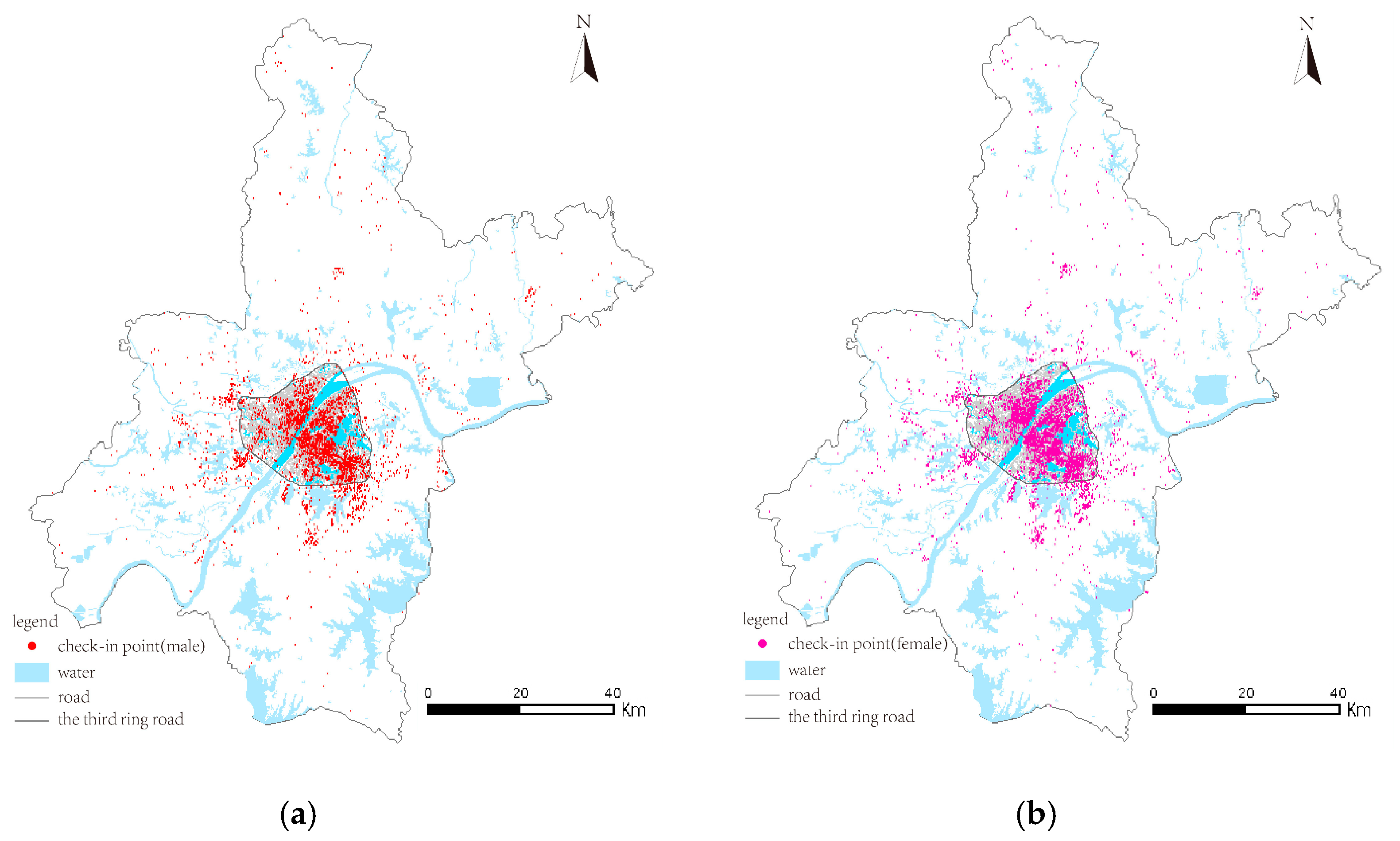
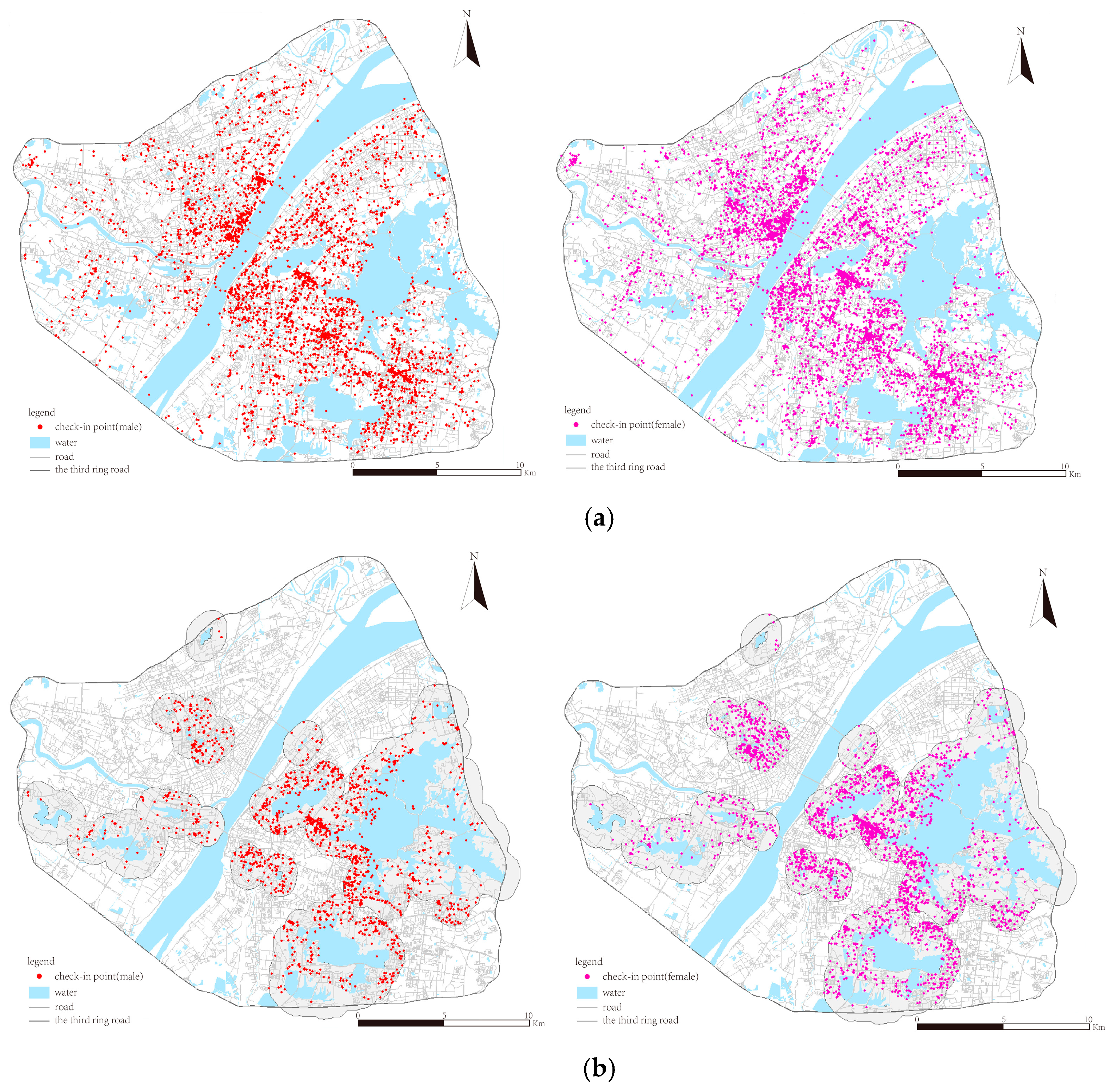


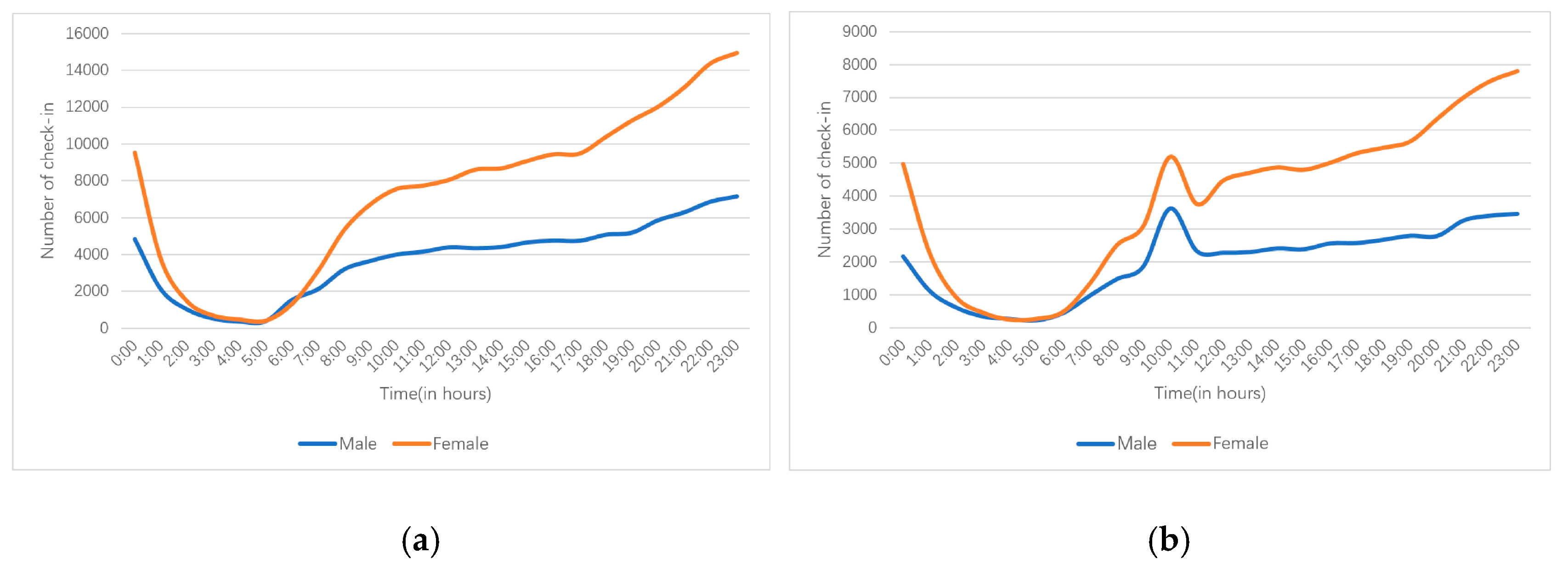



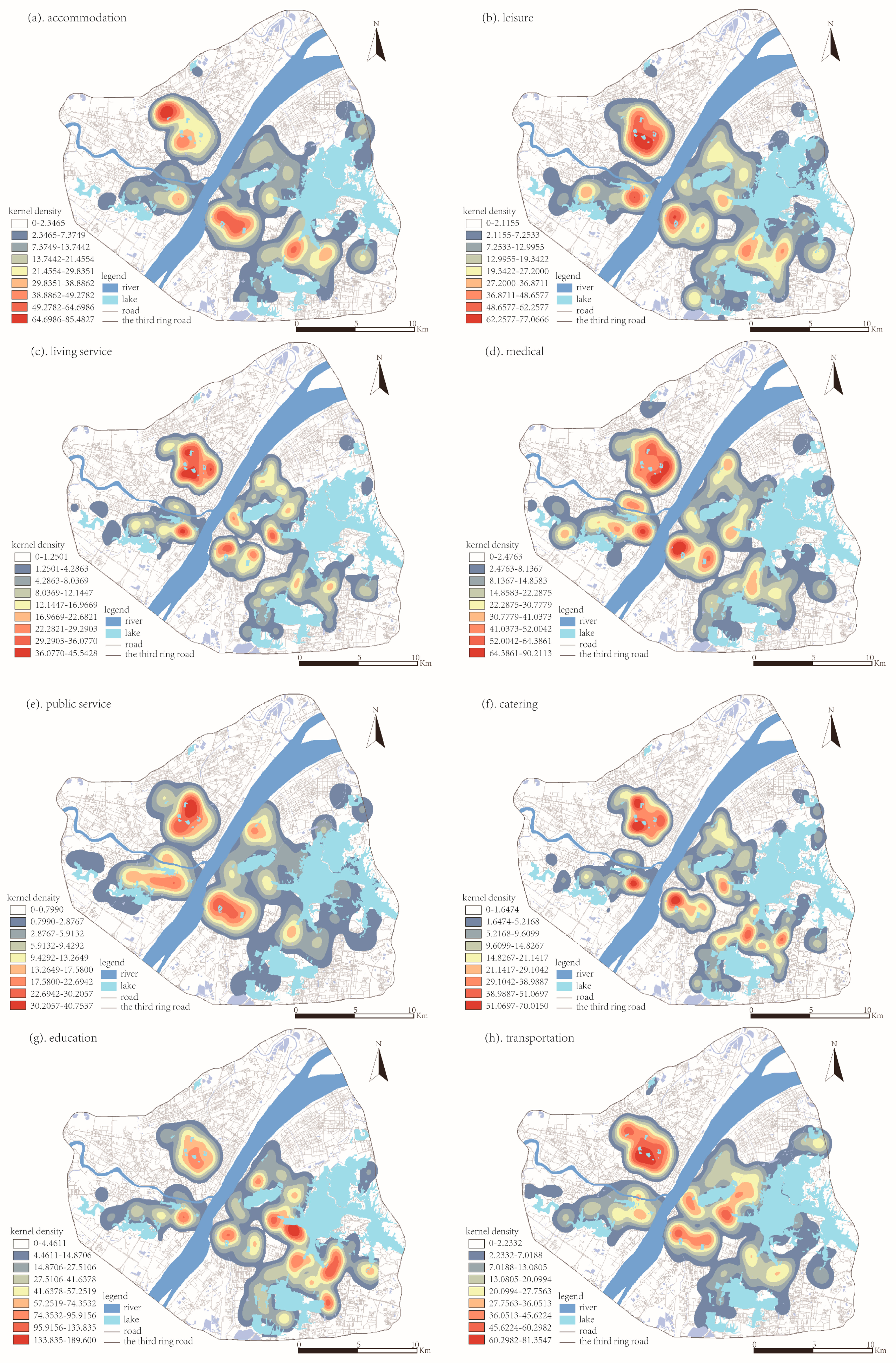
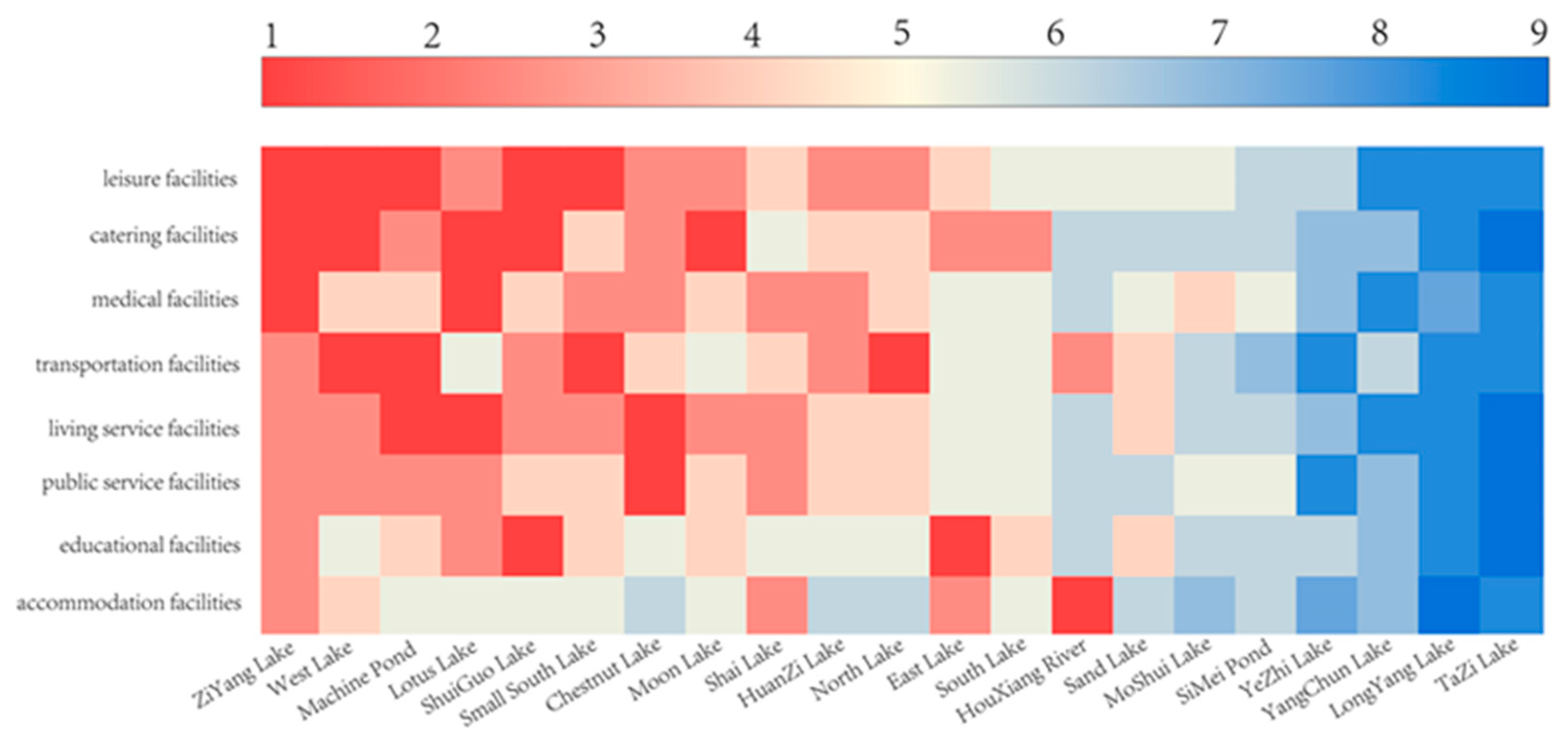
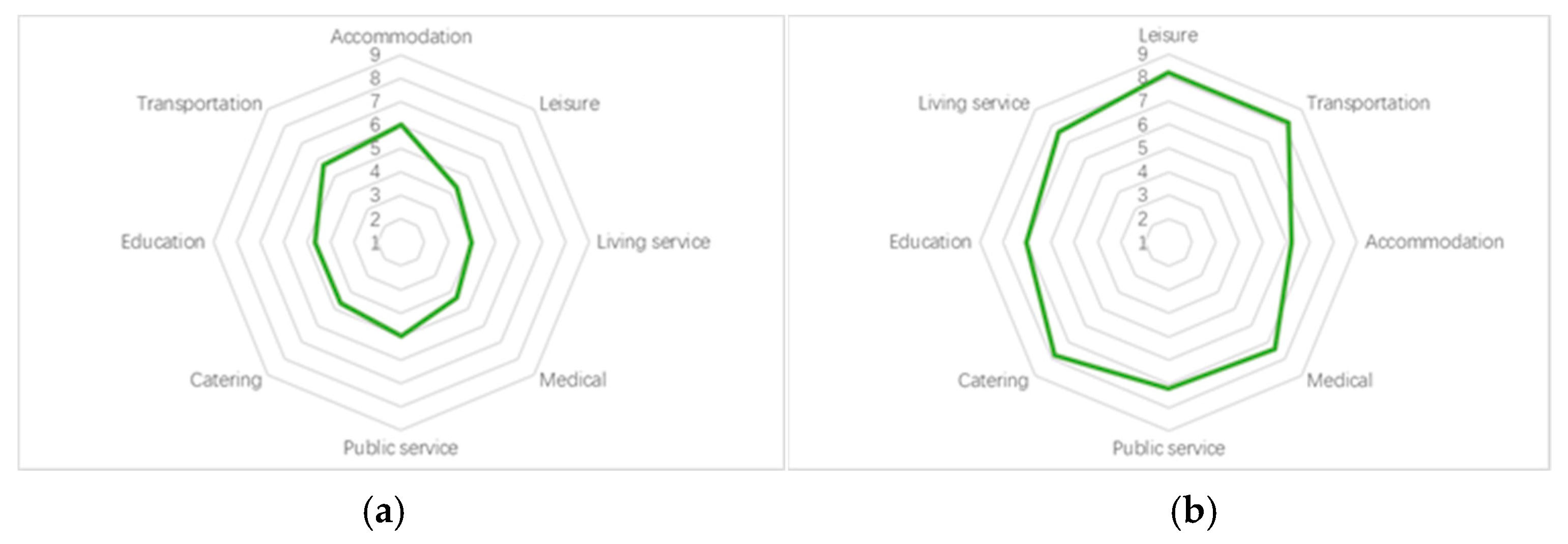

| Week | Male | Female | |
|---|---|---|---|
| Weekday | 22.30% | 43.10% | 0.63 |
| Weekend | 11.70% | 22.90% | 0.65 |
| Mon | 4.69% | 8.96% | 0.62 |
| Tue | 4.29% | 8.28% | 0.63 |
| Wed | 4.19% | 8.15% | 0.64 |
| Thu | 4.47% | 8.51% | 0.62 |
| Fri | 4.66% | 9.19% | 0.65 |
| Sat | 5.87% | 11.28% | 0.63 |
| Sun | 5.83% | 11.63% | 0.66 |
| Lake | Male | Female | ||||
|---|---|---|---|---|---|---|
| Number of Check-ins | Area (km²) | Density | Number of Check-ins | Area (km²) | Density | |
| Shuiguo Lake | 16234 | 4.15 | 3911.81 | 36387 | 4.15 | 8767.95 |
| Sand Lake | 21890 | 14.91 | 1468.14 | 49863 | 14.91 | 3344.27 |
| Yangchun Lake | 8951 | 7.84 | 1141.71 | 10346 | 7.84 | 1319.64 |
| Shai Lake | 4097 | 3.99 | 1026.82 | 6654 | 3.99 | 1667.67 |
| South Lake | 30407 | 31.93 | 952.30 | 65978 | 31.93 | 2066.33 |
| East Lake | 64127 | 88.32 | 726.08 | 121489 | 88.32 | 1375.55 |
| Yezhi Lake | 8410 | 12.75 | 659.61 | 18023 | 12.75 | 1413.57 |
| Lotus Lake | 2634 | 4.03 | 653.60 | 4595 | 4.03 | 1140.20 |
| Ziyang Lake | 2569 | 4.23 | 607.33 | 6155 | 4.23 | 1455.08 |
| Houxiang River | 1786 | 3.69 | 484.01 | 2225 | 3.69 | 602.98 |
| Simei Pond | 1720 | 4.37 | 393.59 | 1921 | 4.37 | 439.59 |
| Small South Lake | 961 | 3.25 | 295.69 | 2674 | 3.25 | 822.77 |
| Machine Pond | 1020 | 3.85 | 264.94 | 2645 | 3.85 | 687.01 |
| North Lake | 932 | 3.78 | 246.56 | 2450 | 3.78 | 648.15 |
| West Lake | 827 | 3.54 | 233.62 | 2102 | 3.54 | 593.79 |
| Huanzi Lake | 704 | 3.97 | 177.33 | 1635 | 3.97 | 411.84 |
| Chestnut Lake | 576 | 3.89 | 148.07 | 1389 | 3.89 | 357.07 |
| Moon Lake | 507 | 7.24 | 70.03 | 1176 | 7.24 | 162.43 |
| Moshui Lake | 485 | 18.1 | 26.80 | 1093 | 18.1 | 60.39 |
| Longyang Lake | 199 | 9.37 | 21.24 | 487 | 9.37 | 5.17 |
| Tazi Lake | 69 | 5.17 | 13.35 | 120 | 5.17 | 23.21 |
| Lake | Male | Female |
|---|---|---|
| Shuiguo Lake | 1 | 1 |
| Sand Lake | 2 | 2 |
| South Lake | 3 | 3 |
| Shai Lake | 4 | 4 |
| Ziyang Lake | 9 | 5 |
| Yezhi Lake | 7 | 6 |
| East Lake | 6 | 7 |
| Yangchun Lake | 3 | 8 |
| Lotus Lake | 8 | 9 |
| Small South Lake r | 12 | 10 |
| Machine Pond | 13 | 11 |
| North Lake | 14 | 12 |
| Houxiang River | 10 | 13 |
| West Lake | 15 | 14 |
| Simei Pond | 11 | 15 |
| Huanzi Lake | 16 | 16 |
| Chestnut Lake | 17 | 17 |
| Moon Lake | 18 | 18 |
| Moshui Lake | 19 | 19 |
| Longyang Lake | 20 | 20 |
| Tazi Lake | 21 | 21 |
| Gender | Cluster | ||||
|---|---|---|---|---|---|
| 1 | 2 | 3 | 4 | ||
| Time | 10:00 | 13:24 | 19:04 | 5:01 | |
| Number | 2311.56 | 477.93 | 791.33 | 122.46 | |
| Male | Number of cases | 2 | 243 | 86 | 173 |
| Valid Invalid | 504 0 | ||||
| Time | 19:50 | 13:59 | 10:00 | 5:40 | |
| Number | 840.75 | 497.60 | 2331.23 | 136.88 | |
| Female | Number of cases | 70 | 230 | 4 | 200 |
| Valid Invalid | 504 0 | ||||
| Lake | Male | Female |
|---|---|---|
| North Lake | A | B |
| East Lake | A | B |
| Chestnut Lake | A | B |
| South Lake | A | B |
| Sand Lake | A | B |
| Shai Lake | A | B |
| Shuiguo Lak | A | B |
| West Lake | A | B |
| Yezhi Lake | A | B |
| Longyang Lake | A | C |
| Moshui Lake | A | C |
| Small South Lake | A | C |
| Moon Lake | A | C |
| Machine Pond | A | D |
| Ziyang Lake | A | D |
| Lotus Lake | B | D |
| Simei Pond | D | B |
| Tazi Lake | B | B |
| Houxiang River | C | C |
| Huanzi Lake | C | C |
| Yangchun Lake | E | E |
© 2019 by the authors. Licensee MDPI, Basel, Switzerland. This article is an open access article distributed under the terms and conditions of the Creative Commons Attribution (CC BY) license (http://creativecommons.org/licenses/by/4.0/).
Share and Cite
Wu, J.; Li, J.; Ma, Y. A Comparative Study of Spatial and Temporal Preferences for Waterfronts in Wuhan based on Gender Differences in Check-In Behavior. ISPRS Int. J. Geo-Inf. 2019, 8, 413. https://0-doi-org.brum.beds.ac.uk/10.3390/ijgi8090413
Wu J, Li J, Ma Y. A Comparative Study of Spatial and Temporal Preferences for Waterfronts in Wuhan based on Gender Differences in Check-In Behavior. ISPRS International Journal of Geo-Information. 2019; 8(9):413. https://0-doi-org.brum.beds.ac.uk/10.3390/ijgi8090413
Chicago/Turabian StyleWu, Jing, Jingwen Li, and Yue Ma. 2019. "A Comparative Study of Spatial and Temporal Preferences for Waterfronts in Wuhan based on Gender Differences in Check-In Behavior" ISPRS International Journal of Geo-Information 8, no. 9: 413. https://0-doi-org.brum.beds.ac.uk/10.3390/ijgi8090413





